Jesse
Van
Epenhuijsen
Jesse
Van
Epenhuijsen
‘Shattered, broken, splintered but held together’
Adjectives are generally used to describe nouns, defining their semantic role within sentences. In the work Shattered, broken, splintered, but held together adjectives are carefully positioned on a radiator.
In their spine-like disposition, the engravings are forcibly attached with hardware that is originally meant for plumbing and radiator installation. They seem to be stuck, pinned, held down by heavy stainless steel bolts, nuts and clamps that want to trap their descriptive, situated nature.
The adjectives are selected from a series of novels, all based in and around urban landscapes, depicting the complicated and multilayered lives of people who live in cities. Similarly to the glass-like engravings, the characters in the books feel trapped, and due to the lives they’ve led, stuck in between lives.
Their nameless struggles solidify and transform into words representing their contradicting existence, occupying the already existing infrastructure of the radiator in the exhibition space.
Photography: Jesse van Epenhuijsen
PLexiglass, hardware
2025
2025
Adjectives are generally used to describe nouns, defining their semantic role within sentences. In the work Shattered, broken, splintered, but held together adjectives are carefully positioned on a radiator.
In their spine-like disposition, the engravings are forcibly attached with hardware that is originally meant for plumbing and radiator installation. They seem to be stuck, pinned, held down by heavy stainless steel bolts, nuts and clamps that want to trap their descriptive, situated nature.
The adjectives are selected from a series of novels, all based in and around urban landscapes, depicting the complicated and multilayered lives of people who live in cities. Similarly to the glass-like engravings, the characters in the books feel trapped, and due to the lives they’ve led, stuck in between lives.
Their nameless struggles solidify and transform into words representing their contradicting existence, occupying the already existing infrastructure of the radiator in the exhibition space.
Photography: Jesse van Epenhuijsen

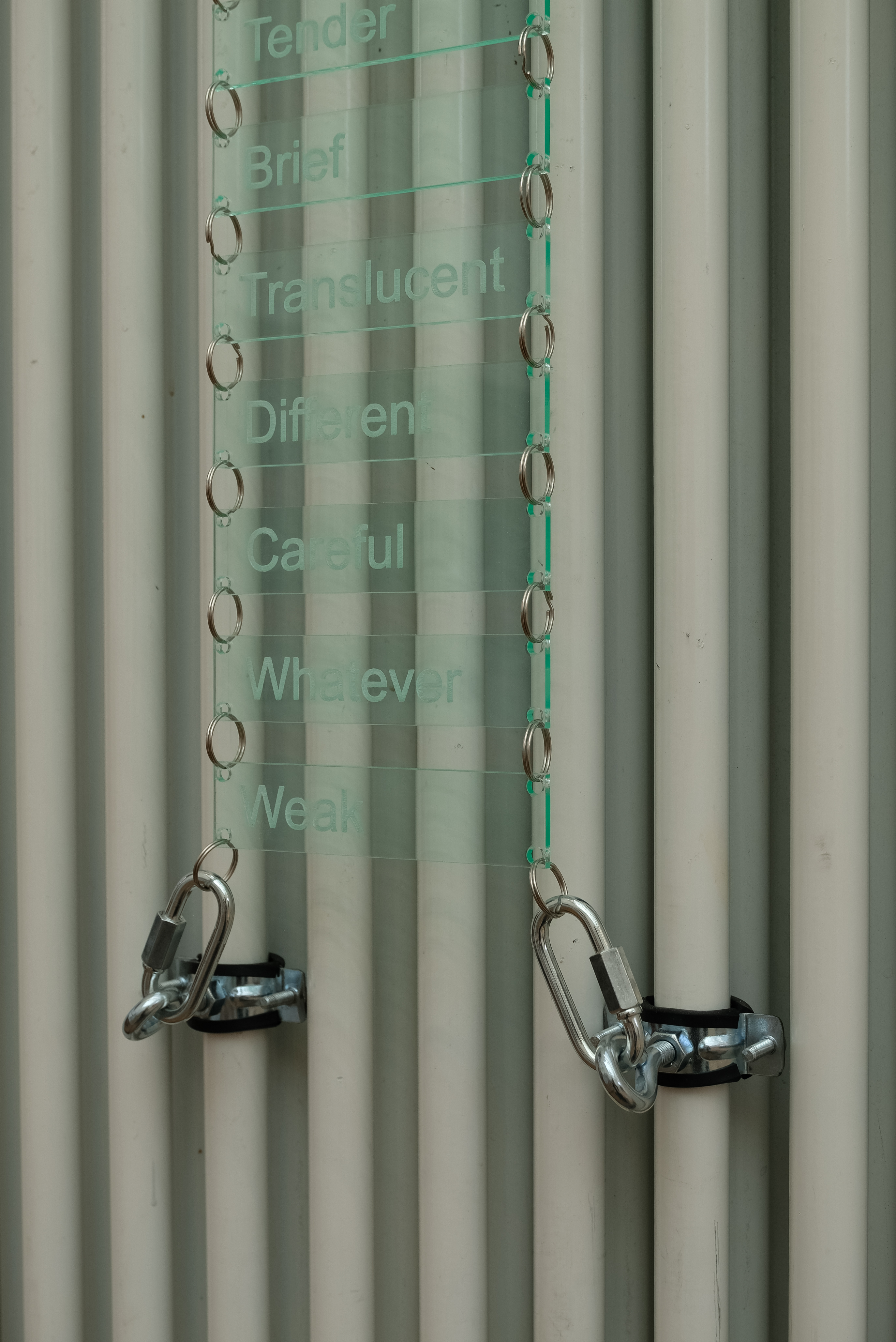


‘Window Wash’
When stores get renovated, demolished or go out of business, retail owners tend to not like it when passersby see what is happening inside. Either to build anticipation for what is to come, to conceal the rubble and shame of a failed business, or simply because the business’s liminal states do not comply with standards. Retailers and construction workers have found a cheap, cost-effective method to shield windows in the dairy aisle; If you brush or roll on low fat yoghurt over the glass it creates a thin, foggy film without obstructing too much natural light.
It’s a common sight in big cities; white-washed shop facades conceal the public view, especially in cities where there is a lot of change, gentrificatrion or other forms of spatial rearrangements. The window, in a way, represents these distinct changes that are either in progress, have passed or continue to be underway.
Photography: Rachael Thorleifson
Window paint, debris, caulk, small electronics
2025
2025
When stores get renovated, demolished or go out of business, retail owners tend to not like it when passersby see what is happening inside. Either to build anticipation for what is to come, to conceal the rubble and shame of a failed business, or simply because the business’s liminal states do not comply with standards. Retailers and construction workers have found a cheap, cost-effective method to shield windows in the dairy aisle; If you brush or roll on low fat yoghurt over the glass it creates a thin, foggy film without obstructing too much natural light.
It’s a common sight in big cities; white-washed shop facades conceal the public view, especially in cities where there is a lot of change, gentrificatrion or other forms of spatial rearrangements. The window, in a way, represents these distinct changes that are either in progress, have passed or continue to be underway.
Photography: Rachael Thorleifson



‘A B is a B and a B’
In this video work, a series of existing and handmade fonts merge together to present the letter B. Constantly ever-changing from one font to another, the shape becomes unrecognizable in moments of transition creating new, undefined letter-like forms. Here, the letter B represents a world of unresolved emotions, doubts and uncertainty; Being always second in-line growing up, being selected last, belonging nowhere, second chances.
B is the second letter in the Latin and modern English alphabet. In some cases, it becomes a silent letter, like lamb or comb. The letter has, in some ways, transformative qualities that either fail to be pronounced or become dull, different and stumped. In this regard, B has a fluid character waiting to be defined. Utilizing this duality, this video work introduces an uncertainty in shape and definition while recognizing the emotive capacities of this specific letter.
Photography: Rachael Thorleifson
Wall-mount, media player, screen, 9”
2025
2025
In this video work, a series of existing and handmade fonts merge together to present the letter B. Constantly ever-changing from one font to another, the shape becomes unrecognizable in moments of transition creating new, undefined letter-like forms. Here, the letter B represents a world of unresolved emotions, doubts and uncertainty; Being always second in-line growing up, being selected last, belonging nowhere, second chances.
B is the second letter in the Latin and modern English alphabet. In some cases, it becomes a silent letter, like lamb or comb. The letter has, in some ways, transformative qualities that either fail to be pronounced or become dull, different and stumped. In this regard, B has a fluid character waiting to be defined. Utilizing this duality, this video work introduces an uncertainty in shape and definition while recognizing the emotive capacities of this specific letter.
Photography: Rachael Thorleifson



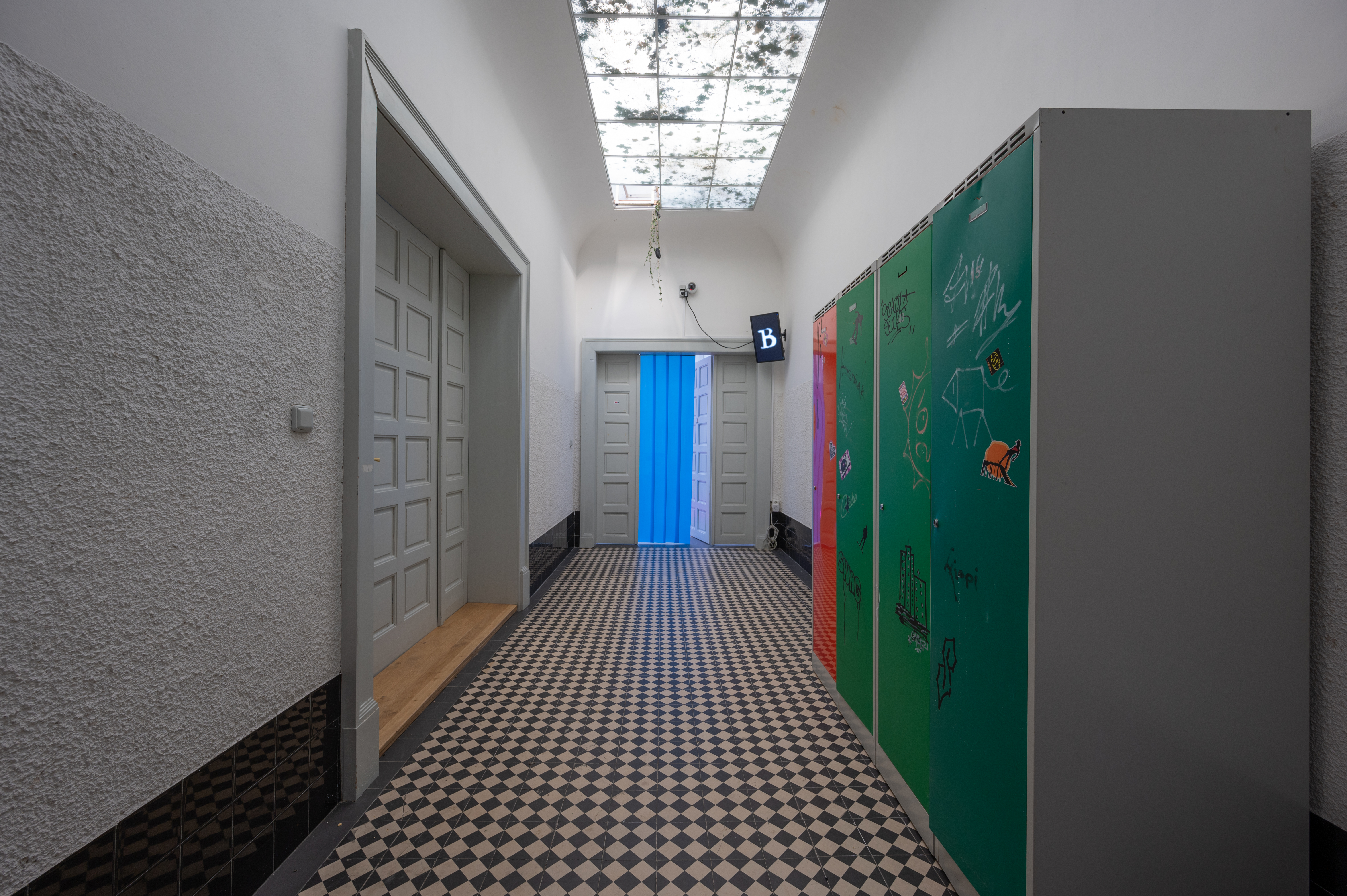
‘Where does this next life lead us’
This work combines a series of essays, short stories and thoughts gathered together in a 9-minute soundpiece. The erratically written fragments are a way of processing the contemporary conditions in Western cities. They glue together ambiguous activities; flying to a random city because you’re feeling sad; coworking with your colleagues; drinking overpriced matcha lattes in a nameless gentrified coffee place. We hear stories of cold brews by the beach, co-existing, and a test of knowledge in a globalized world. Here nothing and everything feels good, and the ruse of knowledge and accessibility keeps you mesmerized, drifting somewhere but not necessarily anywhere.
The work is presented in a series of four school lockers, a place where usually high school students would leave their mark on the locker doors: hide their books, lunch and share gossip.. The gentle whisper tells you tales of modern life and its struggles, with a hypnotizing voice that numbs and lightens the heaviness of it all..
Together, they set the scene of an individual living in a city that may sound specific but could be a multitude of modernized cities simultaneously – a double life. The ambiguity of it all is present in the words, their contradictions and their attempt to understand.
Photography: Rachael Thorleifson
Click here for soundtrack
Used school lockers, audio fragment, 9”
2025
2025
This work combines a series of essays, short stories and thoughts gathered together in a 9-minute soundpiece. The erratically written fragments are a way of processing the contemporary conditions in Western cities. They glue together ambiguous activities; flying to a random city because you’re feeling sad; coworking with your colleagues; drinking overpriced matcha lattes in a nameless gentrified coffee place. We hear stories of cold brews by the beach, co-existing, and a test of knowledge in a globalized world. Here nothing and everything feels good, and the ruse of knowledge and accessibility keeps you mesmerized, drifting somewhere but not necessarily anywhere.
The work is presented in a series of four school lockers, a place where usually high school students would leave their mark on the locker doors: hide their books, lunch and share gossip.. The gentle whisper tells you tales of modern life and its struggles, with a hypnotizing voice that numbs and lightens the heaviness of it all..
Together, they set the scene of an individual living in a city that may sound specific but could be a multitude of modernized cities simultaneously – a double life. The ambiguity of it all is present in the words, their contradictions and their attempt to understand.
Photography: Rachael Thorleifson
Click here for soundtrack


‘Drawing as Thinking: A Week-long Artistic Extravaganza at BRUTUS’
For the BRUTUS Take Over on the weekend of 8 to 11 August 2024, the artist realised a project at BRUTUS Rotterdam. This project consisted of a series of workshops and encounters in which drawing was central.
The project used the power of imagination to generate exciting new ideas, works, and methodologies around art and creativity.
Each day, a different artist, including Ellie McGuinness, Alejandra Lopez, and Tim Mulder, came together with a group of participants to create a large-scale drawing on a roll of paper, which gradually filled BRUTUS’ project space.
The drawings were created in workshops led by these invited artists, who organised and executed the sessions in their own distinctive ways, collaborating closely with the artist. By the end of the week, these drawings were curated into one cohesive, spatial installation.
Participating artists: Jesse van Epenhuijsen, Ellie McGuinness, Tim Mulder, Alejandra Lopez
Photography: Rick van der Klooster
Workshop and exhibition
2024
2024
For the BRUTUS Take Over on the weekend of 8 to 11 August 2024, the artist realised a project at BRUTUS Rotterdam. This project consisted of a series of workshops and encounters in which drawing was central.
The project used the power of imagination to generate exciting new ideas, works, and methodologies around art and creativity.
Each day, a different artist, including Ellie McGuinness, Alejandra Lopez, and Tim Mulder, came together with a group of participants to create a large-scale drawing on a roll of paper, which gradually filled BRUTUS’ project space.
The drawings were created in workshops led by these invited artists, who organised and executed the sessions in their own distinctive ways, collaborating closely with the artist. By the end of the week, these drawings were curated into one cohesive, spatial installation.
Participating artists: Jesse van Epenhuijsen, Ellie McGuinness, Tim Mulder, Alejandra Lopez
Photography: Rick van der Klooster
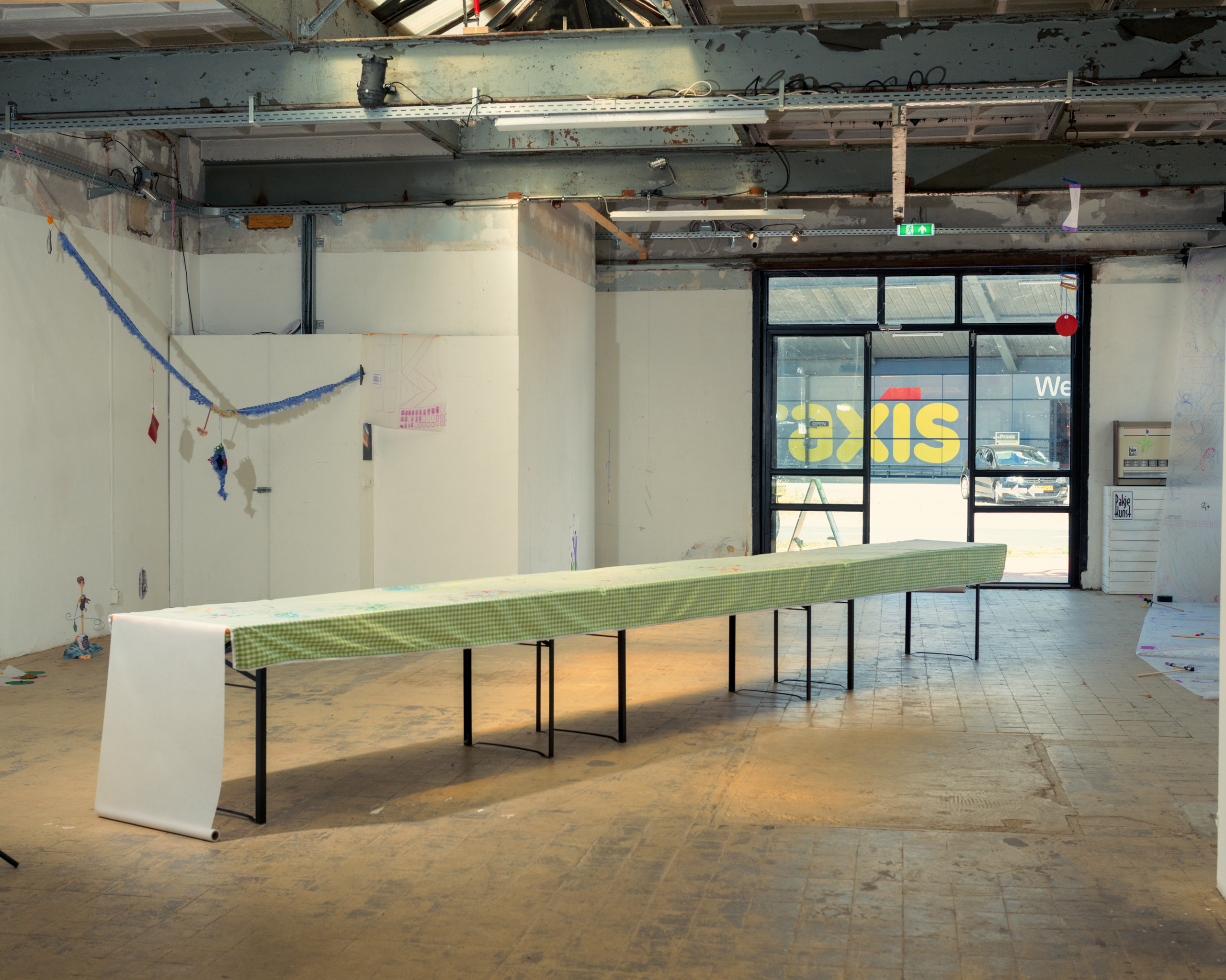
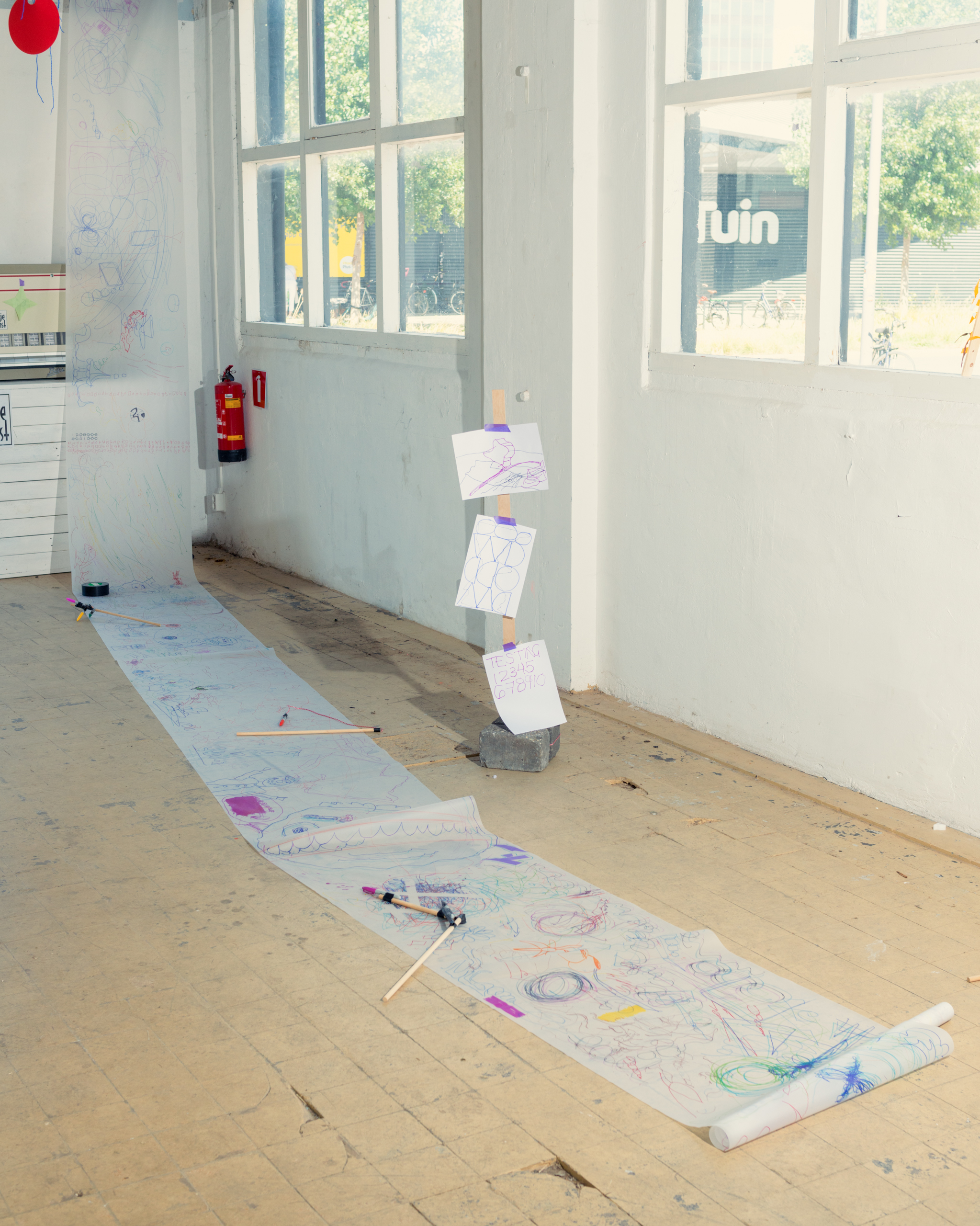

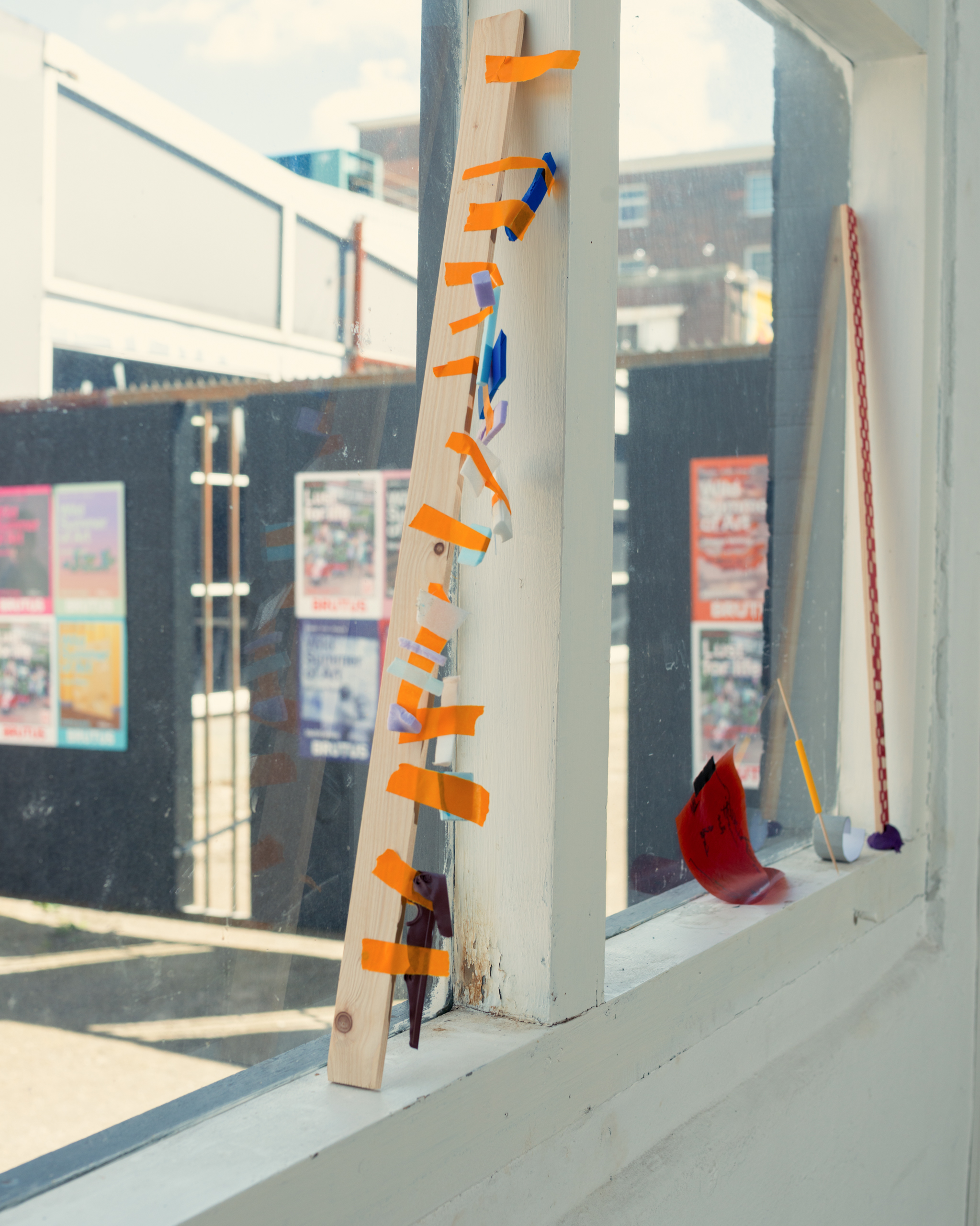

‘Away from a solid Support’
The texts depicted on the various works loosely refer to safety instructions from vintage contractor’s manuals. These texts are used because of the location: the former brothel at Oosteinde 7-11 in Amsterdam had been completely stripped of its previous function. An empty shell, a few struts and creaking floors was all that remained. The works are a poetic translation for a space that was completely empty and spontaneously filled in by artists, and imminent change looming over the temporary exhibition space.
This work was especially created for the group exhibition Nothing for Something in Amsterdam.
Rubber
2023
2023
The texts depicted on the various works loosely refer to safety instructions from vintage contractor’s manuals. These texts are used because of the location: the former brothel at Oosteinde 7-11 in Amsterdam had been completely stripped of its previous function. An empty shell, a few struts and creaking floors was all that remained. The works are a poetic translation for a space that was completely empty and spontaneously filled in by artists, and imminent change looming over the temporary exhibition space.
This work was especially created for the group exhibition Nothing for Something in Amsterdam.
‘Section E’
This project was completed in collaboration with artist Fenna Koot. “Section E” explored different ways of processing site-specific information, such as seeing the building we were presenting the work in as an archive and recreating pieces of information on-site through performance and installation. This project was done in collaboration with Fenna Koot.
Through looking at the building as an archive, we created a multilayered presentation that used the architecture of the space to research and make visible socio-economic changes in the area and transformations that were not always present in the physical space.
Photography by Naomi Moonlion
meranti wood, multiplex, construction cover
Spacial Installation / Intervention
2022
Spacial Installation / Intervention
2022
This project was completed in collaboration with artist Fenna Koot. “Section E” explored different ways of processing site-specific information, such as seeing the building we were presenting the work in as an archive and recreating pieces of information on-site through performance and installation. This project was done in collaboration with Fenna Koot.
Through looking at the building as an archive, we created a multilayered presentation that used the architecture of the space to research and make visible socio-economic changes in the area and transformations that were not always present in the physical space.
Photography by Naomi Moonlion





‘Possibility work’
Meranti wood, multiplex, construction cover
2022
Possibility Work was created in response to an incomplete apartment building surrounded by scaffolding near the exhibition space, which inspired the title of the piece. Much like the building, the work itself remains “under construction,” embodying the idea of transition and potential within urban environments. The artist reinterpreted the patterns commonly found in scaffolding sites, translating them into wooden construction plates.
A printed construction cover, woven throughout the work, added layers of meaning and visual depth. The printed cover was a collaboration with textual artist Puck Kroon. Over the course of the exhibition’s development, Kroon visited multiple times to document the creative process, paralleling the role of a superintendent monitoring the progress of a construction site.
Possibility Work was presented during Zo Dringend Als Het Is/As Urgent As It Can Be at de Bouwput in Amsterdam Sloterdijk.
Meranti wood, multiplex, construction cover
2022
Possibility Work was created in response to an incomplete apartment building surrounded by scaffolding near the exhibition space, which inspired the title of the piece. Much like the building, the work itself remains “under construction,” embodying the idea of transition and potential within urban environments. The artist reinterpreted the patterns commonly found in scaffolding sites, translating them into wooden construction plates.
A printed construction cover, woven throughout the work, added layers of meaning and visual depth. The printed cover was a collaboration with textual artist Puck Kroon. Over the course of the exhibition’s development, Kroon visited multiple times to document the creative process, paralleling the role of a superintendent monitoring the progress of a construction site.
Possibility Work was presented during Zo Dringend Als Het Is/As Urgent As It Can Be at de Bouwput in Amsterdam Sloterdijk.
Photography: Rick van der Klooster



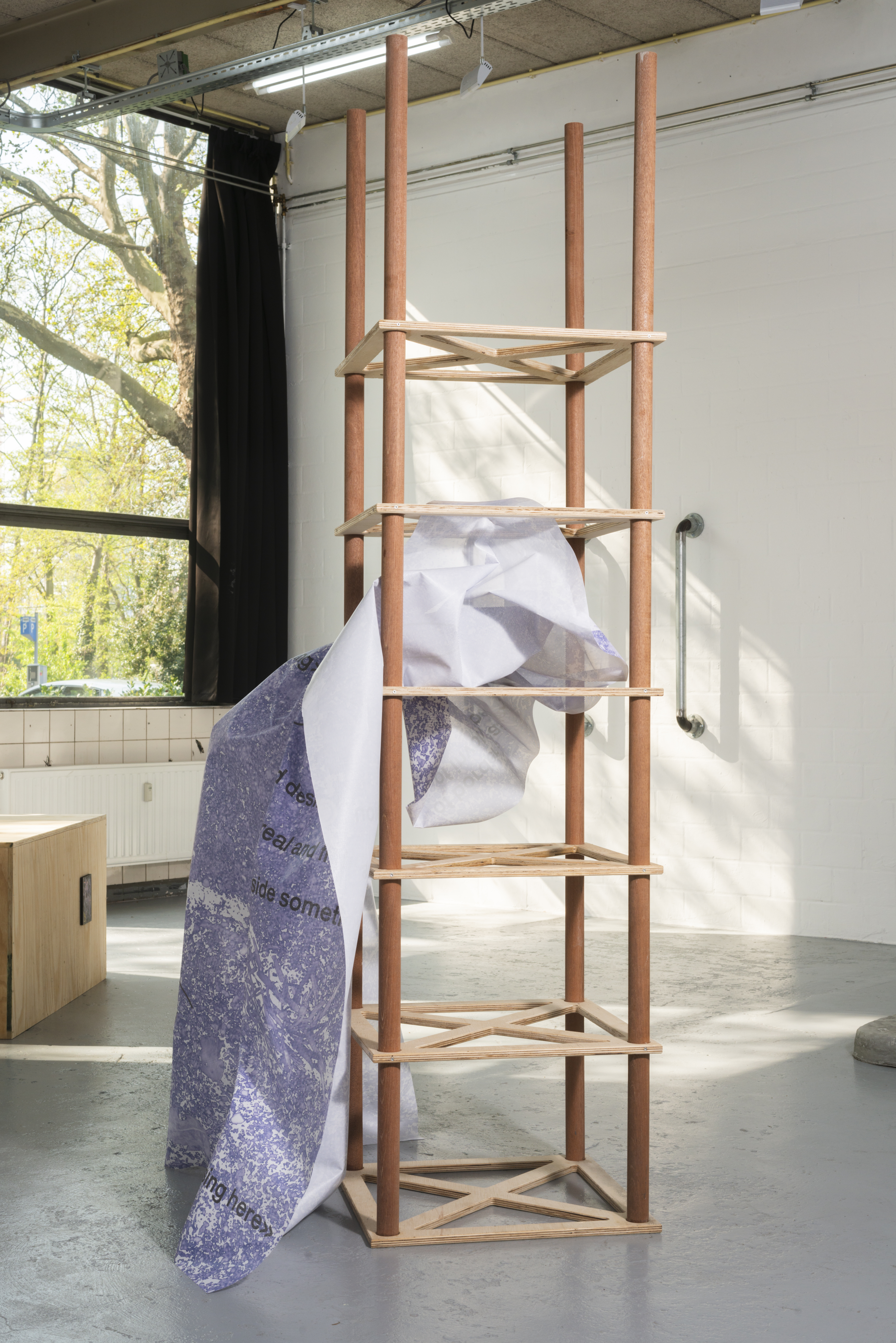
‘Ease of Access’
Scaffolding pipes, connectors
2022
This work is designed to provide physical support, inviting visitors to lean on it when in need. Inspired by handrails commonly found in areas where access may be limited, the piece reimagines these everyday structures as tools for interaction and exploration.
The installation consisted of three aligned pieces, placed without offering clear direction as to where these “practical assistants” might lead. The ambiguity encouraged visitors to engage with the work directly—hanging, leaning, pushing, and pulling in various directions on the presented works.
Ease of Access was presented during Zo Dringend Als Het Is/As Urgent As It Can Be at de Bouwput in Amsterdam Sloterdijk.
Scaffolding pipes, connectors
2022
This work is designed to provide physical support, inviting visitors to lean on it when in need. Inspired by handrails commonly found in areas where access may be limited, the piece reimagines these everyday structures as tools for interaction and exploration.
The installation consisted of three aligned pieces, placed without offering clear direction as to where these “practical assistants” might lead. The ambiguity encouraged visitors to engage with the work directly—hanging, leaning, pushing, and pulling in various directions on the presented works.
Ease of Access was presented during Zo Dringend Als Het Is/As Urgent As It Can Be at de Bouwput in Amsterdam Sloterdijk.
Photography: Rick van der Klooster



‘Mobility Box’
Wood, plexiglass, paint, MDF
2022
The Mobility Box is an installation that combines the function of a resting place while questioning if it’s really designed to sit or rest on. This work of art is loosely inspired by playground objects in the neighborhood of Amsterdam Sloterdijk at De Bouwput, where artist Jesse van Epenhuijsen organized a group exhibition with three other artists.
The show focused on the incoherent cracks and overlaps of the urban infrastructure surrounding De Bouwput, a not-so white cube in Amsterdam Sloterdijk. The installation also presented a work of Hanna-Lee Daled (painting on the side).
Mobility Box was presented during Zo Dringend Als Het Is/As Urgent As It Can Be at de Bouwput in Amsterdam Sloterdijk.
Wood, plexiglass, paint, MDF
2022
The Mobility Box is an installation that combines the function of a resting place while questioning if it’s really designed to sit or rest on. This work of art is loosely inspired by playground objects in the neighborhood of Amsterdam Sloterdijk at De Bouwput, where artist Jesse van Epenhuijsen organized a group exhibition with three other artists.
The show focused on the incoherent cracks and overlaps of the urban infrastructure surrounding De Bouwput, a not-so white cube in Amsterdam Sloterdijk. The installation also presented a work of Hanna-Lee Daled (painting on the side).
Mobility Box was presented during Zo Dringend Als Het Is/As Urgent As It Can Be at de Bouwput in Amsterdam Sloterdijk.
Photography: Rick van der Klooster


‘Who am I to you’
Metal, wood, mechanical parts, flags, spraypaint, concrete
2021
This spatial installation was a commissioned project for Stichting KOP in Breda, conceived as part of a municipal initiative to reinterpret the 1.5-meter distancing rule in public spaces in a positive way. Collaborating with a team of three other artists, the artist developed an installation that not only responded to the distancing measure but also engaged with the unique characteristics of the siteit inhabited. The installation was exhibited in Westerpark, Breda.
To approach the intervention thoughtfully, the artist and the team posed several critical questions: Was this a place meant for passing through or lingering? Did the location already feature other artworks, and if not, was it necessary to introduce one? This final question led to a broader reflection on whether placing art in an unfamiliar environment was justified at all.
As a result, the artist conceptualized an installation that embodied doubt, questioning its own presence and role within the space. Three of the five flagpoles were equipped with mechanisms inside their bases, allowing the flags to be raised or lowered. This interactive design invited engagement from the local community, enabling residents to rearrange the flags and create new compositions.
However, the installation’s journey took an unexpected turn. By the end of the exhibition, two flags had been stolen, and one had been set on fire.
Photography: Rob Lipsius
Metal, wood, mechanical parts, flags, spraypaint, concrete
2021
This spatial installation was a commissioned project for Stichting KOP in Breda, conceived as part of a municipal initiative to reinterpret the 1.5-meter distancing rule in public spaces in a positive way. Collaborating with a team of three other artists, the artist developed an installation that not only responded to the distancing measure but also engaged with the unique characteristics of the siteit inhabited. The installation was exhibited in Westerpark, Breda.
To approach the intervention thoughtfully, the artist and the team posed several critical questions: Was this a place meant for passing through or lingering? Did the location already feature other artworks, and if not, was it necessary to introduce one? This final question led to a broader reflection on whether placing art in an unfamiliar environment was justified at all.
As a result, the artist conceptualized an installation that embodied doubt, questioning its own presence and role within the space. Three of the five flagpoles were equipped with mechanisms inside their bases, allowing the flags to be raised or lowered. This interactive design invited engagement from the local community, enabling residents to rearrange the flags and create new compositions.
However, the installation’s journey took an unexpected turn. By the end of the exhibition, two flags had been stolen, and one had been set on fire.
Photography: Rob Lipsius


